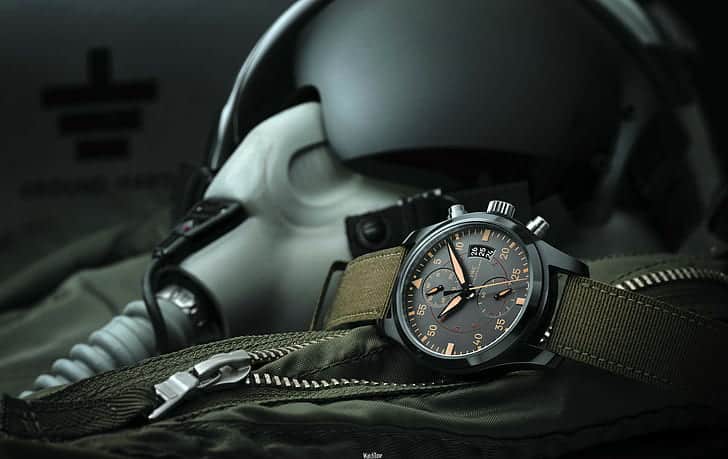What is the best size for a pilot watch?

Have you ever admired the huge sky while observing those gorgeous steel birds soar? Ah, the excitement of flying!
But, my buddy, while the aircraft receives all the attention, a simple piece of equipment—the pilot watch—has been the unsung hero for pilots like myself.
You may be wondering, “What’s in a watch?” or “Why do pilots wear two watches?“. It’s not simply about telling the time, I’ll tell you that much.
Precision, history, and a tradition as extensive as the skies we fly in are all important factors.
Join me as we explore the ideal size for a pilot watch as we travel through the ages. It’s going to be an exciting ride, so fasten your seatbelts!
The Evolution of Pilot Watch Sizes
Pilots needed dependable tools back then when aviation was still in its infancy.
The equipment was basic, and the sky had never been explored. Here comes the pilot’s watch.
These watches started out being huge since they were developed from pocket timepieces. Try retrieving a pocket watch while navigating a jet.
The wristwatch changed everything. Yet size did matter. The dial size affected how easily it could be read at a glance, especially in those high-altitude, adrenaline-inducing situations.
Oversized watches became less necessary as technology developed and cockpits became more complex.
The legacy persisted, nevertheless. Today’s pilot watches come in a variety of sizes, but their precision and dependability—a homage to those early pioneering aviators—remain their core qualities.
Understanding Flieger Watches
The Flieger, ah! a phrase that speaks to every pilot’s soul. The Flieger watches, which have their roots in German aviation, were made with a single goal in mind: functionality.
Type A and Type B were the two main models. While Type B featured a more complex 24-hour dial, Type A had a straightforward 12-hour dial.
The aesthetic was simple, with matte black dials and light indices for great contrast. Why, you inquire? Legibility.
A pilot does not have the luxury of time during a difficult flight maneuver or in the heat of combat.
A short glance ought should do. The size, too? 55mm in diameter, worn on top of the flight suit.
The most important factor was survival, not fashion.
Modern Trends in Pilot Watch Sizes
Pilot watches have evolved, blending design and functionality to meet the needs of aviators and the aesthetic preferences of the public.
A signature feature of these watches is the triangle at the 12 o’clock mark, often flanked by two dots.
This triangle serves a vital purpose: in dim cockpits, it provides a clear reference, allowing pilots to quickly orient the watch and read the time, even in low visibility. (Read our full explanation of why do pilot watches have a triangle.)
Brands like IWC have seamlessly integrated traditional elements like the triangle with modern designs. The Mark XX exemplifies this blend with its 40-mm case and advanced features.
At 43mm, the Big Pilot nods to older, larger watches but is tailored for today’s wrist.
While designs have transformed, the essence of pilot watches remains a tribute to the enduring spirit of aviation, whether 36mm or 55mm in size.
Factors Influencing Pilot Watch Size
Size selection for a pilot’s watch involves more than just personal taste.
It is the result of many different things. As we’ve just covered, legibility is crucial. There’s more, though.
For instance, the large crown is more than just a decorative feature. It serves the aim of enabling pilots to change the time while wearing gloves.
The aesthetic attraction comes next. A pilot’s watch is tough, reflecting the difficulties of flying.
It also has crisp lines, representing the accuracy needed for flight. Modern timepieces strike a balance by providing sizes that accommodate various wrist dimensions without sacrificing their essential qualities.
Wearing a legacy is more important than simply wearing a watch.
Choosing the Right Size for Your Wrist
Things start to get personal at this point. Similar to picking the proper aircraft for a mission, choosing the correct wrist size is important.
It focuses on convenience, style, and comfort. The attraction of oversized timepieces is that they capture the grandeur of flight.
But not everyone will enjoy them. Similar to classic-sized timepieces, they may appear subtle but pack a powerful impact.
There is something for every wrist thanks to brands like IWC who have noticed this and created varieties like the Mark XX or the Big Pilot.
But keep in mind that it’s not all about size. It focuses on the history, tradition, and spirit of aviation.
Decide on a watch that speaks to your soul, one that is an extension of your personality, and a companion in your travels, whether you are a seasoned aviator or an enthusiast.
